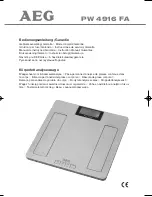
22
Body water content
The body water content in % is normally within the following ranges:
Male
Female
Age
Poor
Good
Very good
Age
Poor
Good
Very good
10–100
<50%
50–65%
>65%
10–100
<45%
45–60%
>60%
Body fat contains relatively little water, therefore body water content may be below the standard values in
persons with a high body fat percentage. On the other hand, endurance athletes may exceed the standard
values due to having low levels of fat and a high muscle percentage.
The body water calculation performed using this scale is not suitable for drawing medical conclusions,
for example in the case of age-related water retention. Consult your doctor where necessary. A high body
water content is generally desirable.
Muscle percentage
The muscle percentage is normally within the following ranges:
Male
Female
Age
Low
Normal
High
Age
Low
Normal
High
10–14
<44%
44–57%
>57%
10–14
<36%
36–43%
>43%
15–19
<43%
43–56%
>56%
15–19
<35%
35–41%
>41%
20–29
<42%
42–54%
>54%
20–29
<34%
34–39%
>39%
30–39
<41%
41–52%
>52%
30–39
<33%
33–38%
>38%
40–49
<40%
40–50%
>50%
40–49
<31%
31–36%
>36%
50–59
<39%
39–48%
>48%
50–59
<29%
29–34%
>34%
60–69
<38%
38–47%
>47%
60–69
<28%
28–33%
>33%
70–100
<37%
37–46%
>46%
70–100
<27%
27–32%
>32%
Bone mass
Like the rest of our body, our bones are subject to natural growth, shrinking and ageing processes. Bone
mass increases rapidly during childhood and reaches its peak between the ages of 30 and 40. As we
age, our bone mass then begins to reduce. You can combat this reduction to an extent with the help of a
healthy diet (particularly calcium and vitamin D) and regular physical exercise. The stability of your skeleton
can be further increased by means of targeted muscle build-up. Please note that this scale does not iden-
tify the total bone mass, but rather just the mineral content of the bone (without water content and without
organic substances). It is very difficult to influence the bone mass, although it does fluctuate slightly within
the scope of influencing factors (weight, height, age, gender). There are no recognised guidelines or recom-
mendations.
IMPORTANT:
Please do not confuse bone mass with bone density.
The bone density can only be determined by means of a medical examination (e.g. computer
tomography, ultrasound). It is therefore not possible to draw conclusions on changes to bones and
bone hardness (e.g. osteoporosis) using this scale.
BMR
The basal metabolic rate (BMR) is the amount of energy required by the body at complete rest in order to
maintain its basic functions (e.g. when lying in bed 24 hours a day). This value is primarily dependent on
weight, height and age.
It is displayed on the diagnostic scale in the unit kcal/day and calculated using the scientifically rec-
ognised Mifflin equation.
This is the amount of energy that is required by your body under all circumstances and must be re-sup-
plied to the body in the form of food. If your energy intake is below this level in the longer term, this can
result in damage to health.
Summary of Contents for SBF 72
Page 51: ...51 1 52 2 52 3 53 4 53 5 55 6 55 7 56 8 61 9 61 10 62 11 63 12 63 8 kg lb st 30 8 BIA BIA...
Page 54: ...54 180 396 28 100 0 2 0 19st 0 2lb 20 28st 1lb 0 1 1 15 10...
Page 59: ...59 BMR BMR Basal Metabolic Rate AMR AMR Active Metabolic Rate 1 5 AMR...
Page 60: ...60 7 3 3 3 Bluetooth 30 Unit Reset 6 7 0 0 Unit Reset 6 Lo 1 CR2032 3...
















































